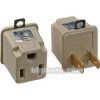bonxer
New Member
When using a tranformerless power supply that isn't isolated, there are all kinds of dire warnings about making sure any test equipment you use on the circuit is powered through an isolation transformer with the wall ground left unconnected. For connecting an oscilloscope, would the following be suitable, or are additional things necessary?




